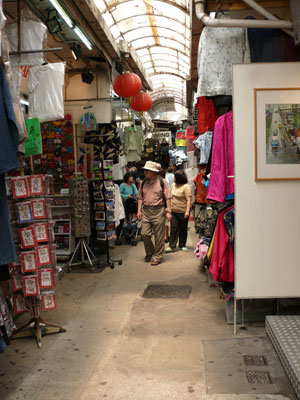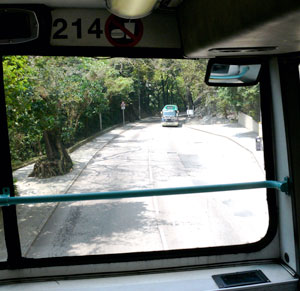HONG KONG - The Star Ferry from Kowloon had no sooner docked at the Central Area pier when a wave of passengers rushed for the exits and headed straight for a convoy of brightly-painted double-decker buses parked opposite the ferry terminal.
“Get on the No. 63 bus,” said Joe Ng, a robust man who promised to show me the Stanley Market area, the high-end residential district where many ex-pats live and where Hong Kong’s famed street market can be found.
The buses, which must navigate narrow, winding roads along Hong Kong’s mountainous coastline to get to Stanley Market, provide passengers with a cheap thrill ride and some spectacular ocean views, especially if you’re sitting on the upper deck.
But by the time we’d reached the bus stop, a long queue had already formed and our chances of getting a coveted upper deck seat had all but vanished.
“Let’s take a taxi instead,” said Joe, a former Hong Kong resident now living in Canada who had returned home on a business trip and who befriended me the night before.
“There’s no sense taking the bus unless you get an upper deck seat and if we take a taxi we can beat this crowd to the market,” said Joe, who added, “we’ll take the No. 63 back down … coming down the mountain, now that’s the REAL thrill ride.
Stanley Market was abuzz with excitement when we reached the entrance. An early-morning crowd of tourists was fanning out into the network of laneways that make up the outdoor icon, one of Hong Kong’s most visited attractions.


Above: The double-decker buses take visitors to Stanley Market, left.
The tourists come here looking for cheap trinkets and souvenirs to take back home from the former British colony that is now firmly a part of China. But unlike the street markets found on the mainland, where “fake” designer items can be purchased for a fraction of the real thing, there’s few bargains or knockoffs to be found in Stanley Market.
“That usually disappoints the tourists,” said Joe, a man who swears he “swam from China to Hong Kong as a boy” to escape his communist homeland.
Minutes later we heard an American woman tell her husband: “This isn’t like the Silk Market in Beijing – they won’t bargain here.”
Many of the items sold at Stanley Market are made by artisans, like the man selling hand-painted T-shirts with his artwork embossed on the front.
“These tourists expect us to give away our work,” he complained. “I won’t bargain – this is my livelihood and I take great pride in my work. These are not fakes. These are my original designs.”
Joe knew every nook and cranny of the compact market where everything from fruit to fabric is sold. But within an hour, we’d covered all of it and Joe insisted it was time to sample some of Stanley Market’s other highlights, like the area’s pubs, leftovers from the colonial era.
The pubs are huddled together along the main street of Stanley Market, a short, narrow road with ancient banyan trees jutting up through the sidewalks. Each is painted a bright, pastel colour and most have open fronts, where tourists and ex-pat clients sit on stools sipping imported brews, sampling fish and chips and talk soccer.
The fashionable area is home to some of the most expensive real estate on the island. Home prices here start in the millions and even the high rise condos, where the ex-pats live, are unaffordable for most Hong Kong residents. The most striking building in the area is the Marine Museum, where the island’s naval past is preserved. The red-stone edifice once served as police headquarters during British rule, and, according to Joe, “was dismantled from its downtown location and brought here piece by piece.”
Standing on the wide colonial-style balcony that wraps around the handsome museum, one gets a panoramic view of the lovely bay that juts into this area. Brightly coloured fishing boats, the kind that wouldn’t look out of place in a Mediterranean port, bobbed on the tranquil turquoise water and offered lots of eye candy for the tourists who were busy clicking pictures. “If you think this is pretty, wait to our bus ride back to the pier – we’ll pass Repulse Bay, the prettiest spot on Hong Kong,” said Joe.
The No. 63 bus stop was a short walk from the museum and a lone American couple was the only others in line. “Head straight upstairs,” said Joe, who insisted on paying the $2 fare.
No sooner had we departed when the driver was forced to make a hairpin turn … then another … and another …
The wide window at the front of the upper deck compartment afforded us an uninterrupted view of the terrifying road ahead and the oncoming traffic, which included other wide double-decker buses that seemed to pass within inches of touching ours.
Our hearts raced faster as the driver, whom we heard nonchalantly whistling below, was forced to dodge small, slower-moving vehicles along Stanley Beach Road, bordered by stately homes and mountain greenery on one side and a steep drop to the ocean on the other.
About 15 minutes later, we came upon Repulse Bay, the recreation area that is home to Hong Kong’s most popular beach and one of the colony’s oldest and most prestigious eateries.
“In the summertime, you can’t find a spot on that beach,” said Joe as the bus rumbled past the small sandy area that supplies residents with a cool respite from the island’s searing summer heat.
Soon the bus pulled into the station opposite the Central Area pier and our thrill ride was over.
During my short stay on this vibrant island, I experienced many thrills thanks to my unofficial guide Joe, but none could come close to the thrill ride known as the No. 63 bus.
About the Author
Marc Atchison is a veteran journalist and a seasoned traveller with more than 20 years of travel writing experience. As the former Travel Editor of the Toronto Star, Canada's largest newspaper, and now Editor-in-Chief and Senior Writer for TraveLife magazine (Canada) and travelife.ca, Marc has been to over 100 countries in the world. Japan is one of his favorite destinations and he's been there on numerous occasions.